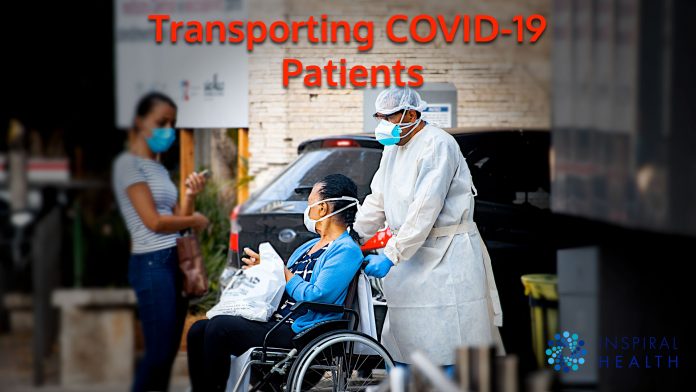Introduction
It is important to limit transport and movement of patients with COVID-19. When transport is necessary don clean PPE, place face mask on patient, and follow respiratory/hygiene etiquette.
Patient transport (on foot or in a wheelchair)
- The wheelchair is covered with a fresh, clean sheet. This remains in the patient’s room after transportation and is subsequently included in the order with the rest of the laundry
- Patient pads are placed in a plastic bag on the wheelchair handle hung up. The plastic bag is disposed of in the patient room
- Patient protective equipment for transport:
- Disposable long-sleeved apron and wrist band; nitrile gloves
- Respirator mask FFP2/N95/KN95
- Personal protective equipment for transport:
- Aprons
- Gloves
- Mouth/nose protection type II/IIR
- Stopping areas of the wheelchair are cared for before/after transport with disinfectant wipes
Patient transport via bed / stretcher
- The bed is covered with a fresh, clean sheet. This remains in the patient’s room after transportation and is subsequently included in the order the rest of the laundry
- Patient pads are placed in a plastic bag at the head of the bed hung up. The plastic bag is disposed of in the patient room
- Patient protective equipment for transport – respirator mask FFP2/N95/KN95
- When transporting with running oxygen application:
- Respirator mask FFP2/N95/KN95 over the oxygen nasal cannula
- With> 8 litres of O2/min:
- Oxygen mask with an upstream reservoir
- Type II/IIR mouth and nose protection over the oxygen mask
- Stopping areas of the bed are cared for before/after transport with disinfectant wipes
Moving patients within the same hospital
- Patient transport is carried out by trained transport personnel or qualified nursing staff
- The movement and transport of patients from their single room/cohort area should be limited to essential purposes only. Staff at the receiving destination must be informed that the patient has possible or confirmed COVID-19
- If transport/movement is necessary, consider offering the patient a surgical face mask to be worn during transportation when this can be tolerated, to minimise the dispersal of respiratory droplets and when clinical care is not compromised
- Patients must be taken straight to and returned from clinical departments and must not wait in communal areas
- If possible, patients should be placed at the end of clinical care lists
- Waiting times in front of examination rooms should be avoided.
Transfer from primary care / community settings
- If transfer from a primary care facility or community setting to hospital is required, the ambulance service should be informed of the infectious status of the patient
- Staff of the receiving ward/department should be notified in advance of any transfer and must be informed that the patient has possible or confirmed COVID-19
Moving patients between different hospitals
Patient transfer from one healthcare facility may be undertaken if medically necessary for specialist care arising out of complications or concurrent medical events (for example, cardiac angioplasty and renal dialysis).
If transfer is essential, the ambulance service and receiving hospital must be advised in advance of the infectious status of the patient.
Sources & links
- Basel Hospital | Epidemic manual SARS-CoV-2 / COVID-19
- UK GOV | Reducing the risk of transmission of COVID-19 in the hospital setting

